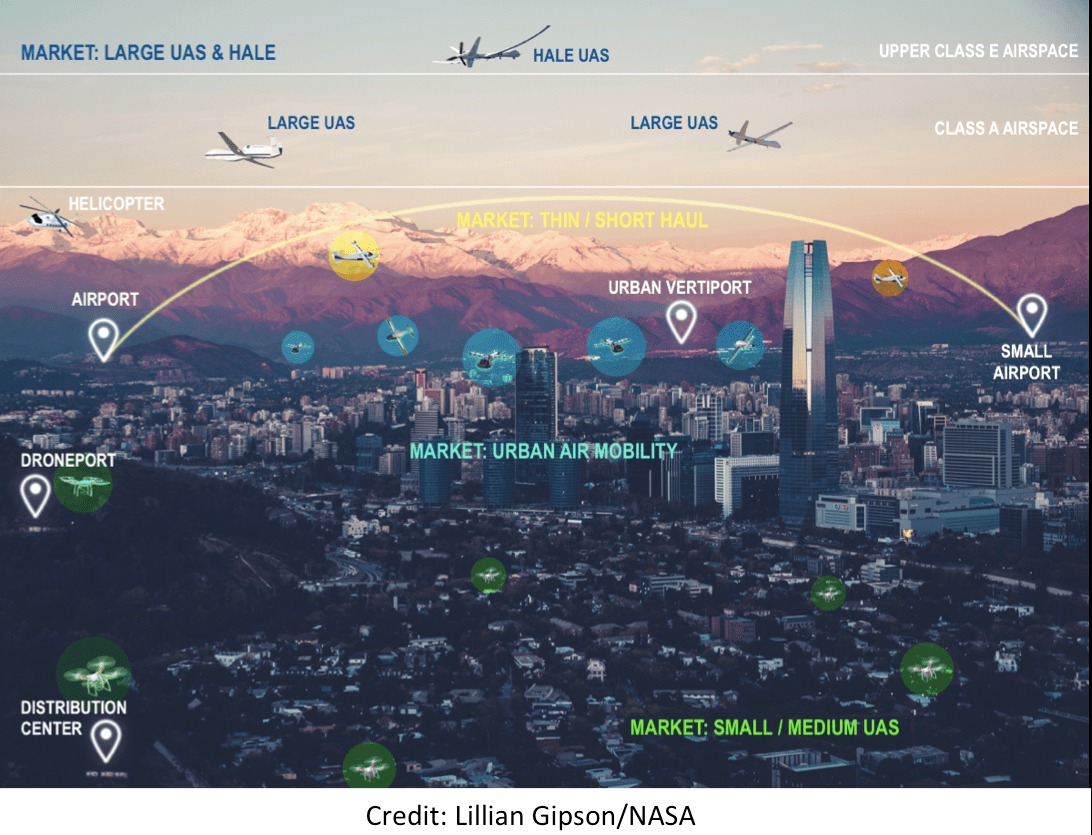
Robohub.org
WAZE for drones: expanding the national airspace

Sitting in New York City, looking up at the clear June skies, I wonder if I am staring at an endangered phenomena. According to many in the Unmanned Aircraft Systems (UAS) industry, skylines across the country soon will be filled with flying cars, quadcopter deliveries, emergency drones, and other robo-flyers. Moving one step closer to this mechanically-induced hazy future, General Electric (GE) announced last week the launch of AiRXOS, a “next generation unmanned traffic” management system.
Managing the National Airspace is already a political football with the Trump Administration proposing privatizing the air-control division of the Federal Aviation Administration (FAA), taking its controller workforce of 15,000 off the government’s books. The White House argues that this would enable the FAA to modernize and adopt “NextGen” technologies to speed commercial air travel. While this budgetary line item is debated in the halls of Congress, one certainty inside the FAA is that the National Airspace (NAS) will have to expand to make room for an increased amount of commercial and recreational traffic, the majority of which will be unmanned.
Ken Stewart, the General Manager of AiRXOS, boasts, “We’re addressing the complexity of integrating unmanned vehicles into the national airspace. When you’re thinking about getting a package delivered to your home by drone, there are some things that need to be solved before we can get to that point.” The first step for the new division of GE is to pilot the system in a geographically-controlled airspace. To accomplish this task, DriveOhio’s UAS Center invested millions in the GE startup. Accordingly, the first test deployment of AiRXOS will be conducted over a 35 mile stretch of Ohio’s Interstate 33 by placing sensors along the road to detect and report on air traffic. GE states that this trial will lay the foundation for the UAS industry. As Alan Caslavka, president of Avionics at GE Aviation, explains, “AiRXOS is addressing the rapid changes in autonomous vehicle technology, advanced operations, and in the regulatory environment. We’re excited for AiRXOS to help set the standard for autonomous and manned aerial vehicles to share the sky safely.”
Stewart whimsically calls his new air traffic control platform WAZE for drones. Like the popular navigation app, AiRXOS provides drone operators with real-time flight-planning data to automatically avoid obstacles, other aircraft, and route around inclement weather. The company also plans to integrate with the FAA to streamline regulatory communications with the agency. Stewart explains that this will speed up authorizations as today, “It’s difficult to get [requests] approved because the FAA hasn’t collected enough data to make a decision about whether something is safe or not.”

NASA is a key partner in counseling the FAA in integrating commercial UAS into the NAS. Charged with removing the “technical and regulatory barriers that are limiting the ability for civil UAS to fly in the NAS” is Davis Hackenberg of NASA’s Armstrong Flight Research Center. Last year, we invited Hackenberg to present his UAS vision to RobotLabNYC. Hackenberg shared with the packed audience NASA’s multi-layered approach to parsing the skies for a wide-range of aircrafts, including: high altitude long endurance flights, commercial airliners, small recreational craft, quadcopter inspections, drone deliveries and urban aerial transportation. Recently the FAA instituted a new regulation mandating that all aircrafts be equipped with Automatic Dependent Surveillance-Broadcast (ADS-B) systems by January 1, 2020. The FAA calls such equipment “foundational NextGen technology that transforms aircraft surveillance using satellite-based positioning,” essentially connecting human-piloted craft to computers on the ground and, quite possibly, in the sky. Many believe this is a critical step towards delivering on the long-awaited promise of the commercial UAS industry with autonomous beyond visual line of sight flights.
I followed up this week with Hackenberg about the news of AiRXOS and the new FAA guidelines. He explained, “For aircraft operating in an ADS-B environment, testing the cooperative exchange of information on position and altitude (and potentially intent) still needs to be accomplished in order to validate the accuracy and reliability necessary for a risk-based safety case.” Hackenberg continued to describe how ADS-B might not help low altitude missions, “For aircraft operating in an environment where many aircraft are not transmitting position and altitude (non-transponder equipped aircraft), developing low cost/weight/power solutions for DAA [Detect and Avoid] and C2 [Command and Control Systems] is critical to ensure that the unmanned aircraft can remain a safe distance from all traffic. Finally, the very low altitude environment (package delivery and air taxi) will need significant technology development for similar DAA/C2 solutions, as well as certified much more (e.g. vehicles to deal with hazardous weather conditions).” The Deputy Project Manager then shared with me his view of the future, “In the next five years, there will be significant advancements in the introduction of drone deliveries. The skies will not be ‘darkened,’ but there will likely be semi-routine service to many areas of the country, particularly major cities. I also believe there will be at least a few major cities with air taxi service using optionally piloted vehicles within the 10-year horizon. Having the pilot onboard in the initial phase may be a critical stepping-stone to gathering sufficient data to justify future safety cases. And then hopefully soon enough there will be several cities with fully autonomous taxi service.”

Last month, Uber already ambitiously declared at its Elevate Summit that its ride-hail program will begin shuttling humans by 2023. Uber plans to deploy electric vertical take-off and landing (eVTOL) vehicles throughout major metropolitan areas. “Ultimately, where we want to go is about urban mobility and urban transport, and being a solution for the cities in which we operate,” says Uber CEO, Dara Khosrowshahi. Uber has been cited by many civil planners as the primary cause for increased urban congestion. Its eVTOL plan, called uberAIR, is aimed at alleviating terrestrial vehicle traffic by offsetting commutes with autonomous air taxis that are centrally located on rooftops throughout city centers.
One of Uber’s first test locations for uberAIR will be Dallas-Fort Worth, Texas. Tom Prevot, Uber’s Director of Engineering for Airspace Systems, describes the company’s effort to design a Dynamic Skylane Networks of virtual lanes for its eVTOLs to travel, “We’re designing our flight paths essentially to stay out of the scheduled air carriers’ flight paths initially. We do want to test some of these concepts of maybe flying in lanes and flying close to each other but in a very safe environment, initially.” To accomplish these objectives, Prevot’s group signed a Space Act Agreement with NASA to determine the requirements for its aerial ride-share network. Using Uber’s data, NASA is already simulating small-passenger flights around the Texas city to identify potential risks to an already crowded airspace.
After the Elevate conference, media reports hyped the immanent arrival of flying taxis. Rodney Brooks (considered by many as the godfather of robotics) responded with a tweet: “Headline says ‘prototype’, story says ‘concept’. This is a big difference, and symptomatic of stupid media hype. Really!!!” Dan Elwell, FAA Acting Administrator, was much more subdued with his opinion of how quickly the technology will arrive, “Well, we’ll see…”
Editor’s Note: This week we will explore regulating unmanned systems further with Democratic Presidential Candidate Andrew Yang and New York State Assemblyman Clyde Vanel at the RobotLab forum on “The Politics Of Automation” in New York City.




